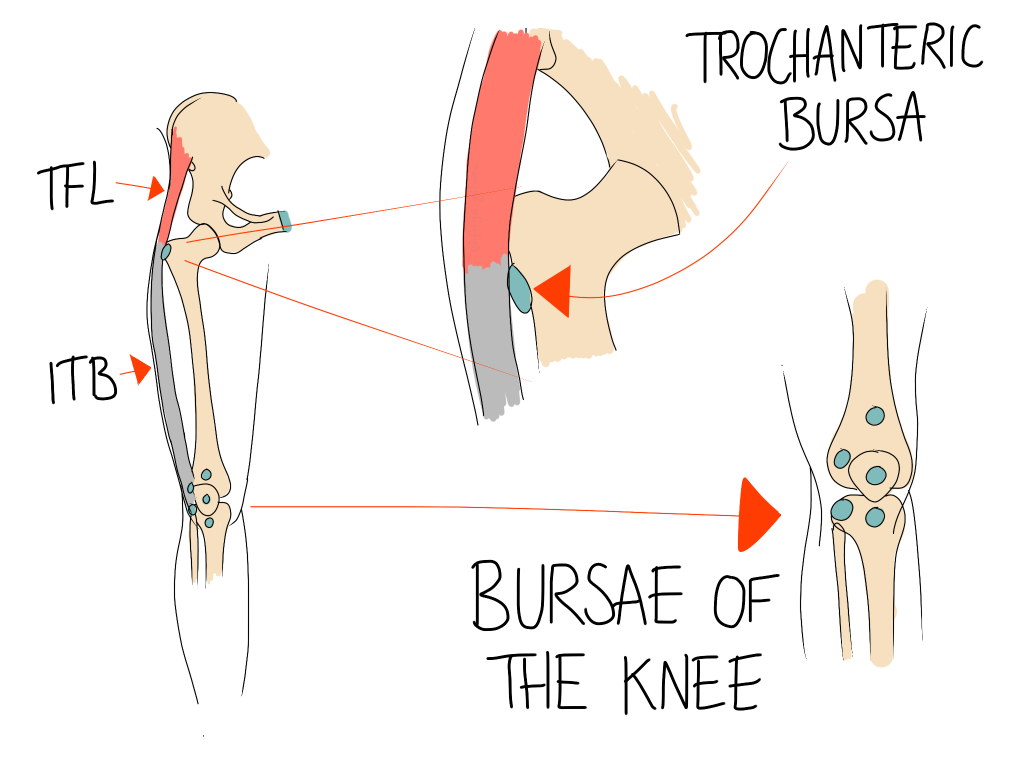The IT band is a band of tissue that runs down the side of the…

Bursitis
Bursae are fatty pads that are present all over the body. They sit between muscles or tendons and bones, and minimise friction on soft tissues. Despite this, they can become irritated themselves, often as a result of excess or repeated pressure. This is bursitis: the inflammation of a bursa. Symptoms may present as a dull ache, which may also be tender to pressure. Sometimes there is also a palpable lump. If the bursa is close to the surface, there may be redness or warmth in the area. If your symptoms persist beyond a week or two, it may be time to find the underlying cause.
Trochanteric Bursitis (hip area)
One of the areas we see most in clinic is around the greater trochanter. This is the lump at the top of the femur (thigh bone). The bursa that sits here protects the soft tissues that run down the outside of the thigh.
 The TFL and ITB are tissues on the outside of the thigh. The TFL is a muscle that blends into the ITB, which is less stretchy and more like a tendon. They work together to stabilise the knee, so tightness here may actually indicate a knee problem. When tight, the two apply extra pressure to the bursa. If this persists, it can lead to bursitis.
The TFL and ITB are tissues on the outside of the thigh. The TFL is a muscle that blends into the ITB, which is less stretchy and more like a tendon. They work together to stabilise the knee, so tightness here may actually indicate a knee problem. When tight, the two apply extra pressure to the bursa. If this persists, it can lead to bursitis.
Olecranon Bursitis (elbow)
Also known as “student’s elbow”, this area can develop a surprisingly large lump. The name “student’s elbow” refers to the usual method of injury: prolonged pressure from leaning on a desk. As there is little tissue above the bursa, swelling can be very prominent, with some cases comparable to the size of an egg. Despite the appearance, the swelling can be painless. As a result, it may be misdiagnosed as a cyst. Removing the irritant will allow the bursa to calm down. This may mean reviewing ergonomics to discourage leaning on the desk. Your osteopath can advise you here, as no one set-up will work for everyone.
Knee Bursitis
There are a number of bursae around the knee. The illustration above shows some of them. Bursae at the front of the knee may be affected by the quadriceps. The knee cap sits within the quadriceps tendon, so tightness in the muscle increases pressure here too. Fortunately these muscles are typically quite responsive to treatment and exercise, so the irritant can be swiftly reduced. If your symptoms are following another problem that has caused your gait to change, your osteopath may be able to help you correct your compensation.
How Your Osteopath Can Help
Inflamed bursae can take a while to calm down, but we can help to relieve the pressure on them. You might find that anti-inflammatory measures such as using a cool compress can help too.
At your appointment we will consider other possible diagnoses. There are a handful of rheumatic conditions that overlap with the symptoms of bursitis. Some of these require medical intervention, so it’s important that we catch them and refer you on to where you need to be. If your pain is sharp or stabbing, it may not be the bursa alone causing it.
As mentioned above, your osteopath may also be able to offer preventative advice. If your symptoms are caused by an activity you routinely do, such as a sport or work, there may be changes you can make to help. This is not to say that we will ask you to stop doing something you love- we want to work with you to find the balance.



